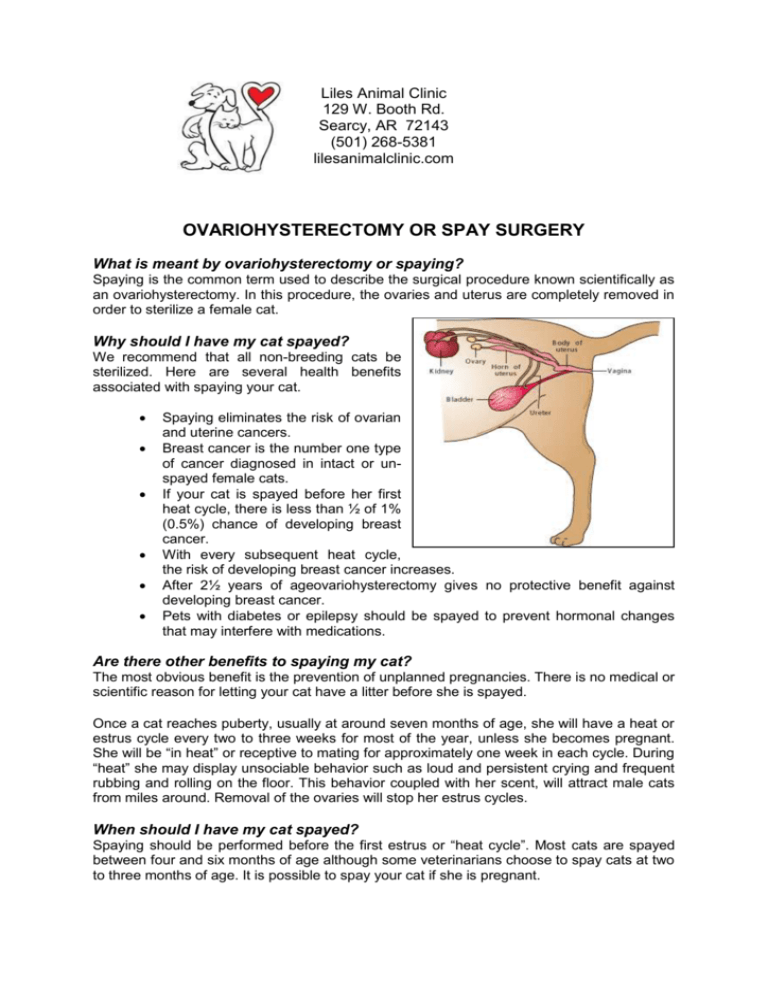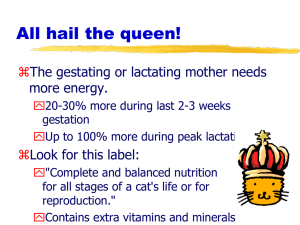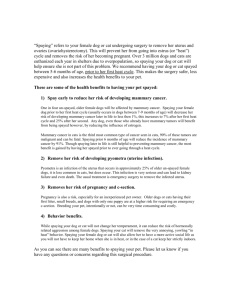OVARIOHYSTERECTOMY OR SPAY SURGERY
advertisement

Liles Animal Clinic 129 W. Booth Rd. Searcy, AR 72143 (501) 268-5381 lilesanimalclinic.com OVARIOHYSTERECTOMY OR SPAY SURGERY What is meant by ovariohysterectomy or spaying? Spaying is the common term used to describe the surgical procedure known scientifically as an ovariohysterectomy. In this procedure, the ovaries and uterus are completely removed in order to sterilize a female cat. Why should I have my cat spayed? We recommend that all non-breeding cats be sterilized. Here are several health benefits associated with spaying your cat. Spaying eliminates the risk of ovarian and uterine cancers. Breast cancer is the number one type of cancer diagnosed in intact or unspayed female cats. If your cat is spayed before her first heat cycle, there is less than ½ of 1% (0.5%) chance of developing breast cancer. With every subsequent heat cycle, the risk of developing breast cancer increases. After 2½ years of ageovariohysterectomy gives no protective benefit against developing breast cancer. Pets with diabetes or epilepsy should be spayed to prevent hormonal changes that may interfere with medications. Are there other benefits to spaying my cat? The most obvious benefit is the prevention of unplanned pregnancies. There is no medical or scientific reason for letting your cat have a litter before she is spayed. Once a cat reaches puberty, usually at around seven months of age, she will have a heat or estrus cycle every two to three weeks for most of the year, unless she becomes pregnant. She will be “in heat” or receptive to mating for approximately one week in each cycle. During “heat” she may display unsociable behavior such as loud and persistent crying and frequent rubbing and rolling on the floor. This behavior coupled with her scent, will attract male cats from miles around. Removal of the ovaries will stop her estrus cycles. When should I have my cat spayed? Spaying should be performed before the first estrus or “heat cycle”. Most cats are spayed between four and six months of age although some veterinarians choose to spay cats at two to three months of age. It is possible to spay your cat if she is pregnant. What does a spay surgery involve? This is a major surgical procedure that requires a full general anesthetic. You will need to fast your cat the night prior to surgery. Most cats return home within forty-eight hours after surgery. The operation is performed through a relatively small incision made most commonly in the midline of the abdomen, just below the umbilicus. Both ovaries are removed along with the entire uterus. The surgical incision will be closed with several layers of sutures. In many cases, skin sutures will be placed, and these will be removed after seven to ten days. Are complications common with spaying? In general, complications are rare during spaying of cats. However, as with all anesthetic and surgical procedures, there is always a small risk. The potential complications include: Anesthetic reaction It is possible that any individual animal could have an adverse reaction following the administration of a drug or anesthetic. Such cases are impossible to predict, but are extremely rare. Pre-operative blood work is a useful screening test that may detect preexisting problems which could interfere with the pet’s ability to handle the anesthetic drugs. It is important that you properly fast your cat prior to surgery according to your veterinarian’s instructions. In addition, any signs of illness or previous medical conditions should be reported to your veterinarian prior to any sedation, anesthesia or surgery. Internal bleeding This can occur if a ligature around a blood vessel breaks or slips off after the abdomen has been closed. This is very rare, and is more likely to occur if the cat is extremely active. Clinical signs include weakness, pale gums, depression, anorexia or a distended abdomen. Post-operative infection This may occur internally or externally around the incision site. In most cases the infection can be controlled with antibiotics. This most commonly occurs when the cat licks the site excessively or is in a damp environment. Sinus formation or Suture Reaction Although extremely rare, occasionally the body will react to certain types of suture material used during surgery. This results in a draining wound or tract that may appear up to several weeks after the surgery was performed. Often a further operation is required to remove the suture material. Will spaying have any affect on my cat? In the vast majority of cats, there are absolutely no adverse affects following spaying. In certain cats, notably the Siamese breed, the hair that grows back over an operation site may be noticeably darker, believed to be due to a difference in the skin temperature. This darker patch may grow out with the following molt as the hair is naturally replaced. There are many myths and rumors that are not supported by facts or research. Be sure to address any questions or concerns you may have with your veterinarian prior to surgery. This client information sheet is based on material written by Ernest Ward, DVM © Copyright 2005 Lifelearn Inc. Used with permission under license. August 1, 2016







